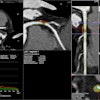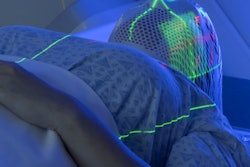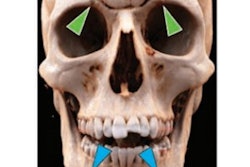
Machine-learning models that assess both peritumoral and intratumoral radiomics features on pretreatment CT images can yield a promising level of performance for predicting treatment outcomes in patients with esophageal squamous cell carcinoma, according to research published online September 10 in JAMA Network Open.
A research team led by Dr. Yihuai Hu of Sun Yat-sen University Cancer Center in Guangzhou, China, found that integrating both peritumoral and intratumoral CT radiomics features into a machine-learning algorithm led to better performance for predicting a patient's complete response to neoadjuvant chemoradiation than a classifier that only considered intratumoral radiomics features.
"Peritumoral radiomics may provide additional predictive value for treatment response estimation in esophageal squamous cell carcinoma and thus benefit individualized therapeutic strategies," the authors wrote.
Although neoadjuvant chemoradiation has been shown to improve long-term outcomes in patients with locally advanced esophageal squamous cell carcinoma, treatment response varies among patients, according to the researchers.
"Accurate pretreatment prediction of response remains an urgent need," they wrote.
The researchers used radiomics features extracted from preoperative CT scans in 161 patients from Sun Yat-sen University Cancer Center to train peritumoral, intratumoral, and combined radiomics models with different types of classifiers. The combined model incorporated 7 intratumoral and 6 peritumoral features.
They then retrospectively tested the best-performing models on a test set of 70 patients from the University of Hong Kong.
| AI performance for predicting complete treatment response in esophageal cancer | |||
| Peritumoral radiomics model | Intratumoral radiomics model | Combined radiomics model | |
| Area under the curve | 0.726 | 0.730 | 0.852 |
The combined radiomics model produced 90.3% sensitivity, 79.5% specificity, and 84.3% accuracy on the test set.
"This study underlines the significant application of peritumoral radiomics to assess treatment response in clinical practice," the authors wrote.
After performing radiogenomic analysis using gene expression profiles on a subset of the training group, the researchers noted that the association of the peritumoral area with response identification might partially be attributed to the type I interferon-related biological process.
In an accompanying editorial, Ruijiang Li, PhD, of Stanford University School of Medicine said that the study represents a step forward toward an individualized approach to treating esophageal cancer. However, several issues still need to be addressed before this method could be implemented.
"First, the generalizability of the imaging signature across different computed tomography scanners and imaging protocols should be rigorously assessed," he said. "Second, because the study investigated multiple machine-learning classifiers with varying levels of accuracy, it will be important to choose a final model, which will be locked before it is ready for further validation in prospective studies."
Li also noted that, in contrast with Western countries, where most esophageal cancers are adenocarcinomas, the patient population in this study comes from a region in southern China where most esophageal cancers are squamous cell carcinomas.
"Given the different response rates to neoadjuvant [chemoradiation therapy] of these 2 histological subtypes, it will be interesting to test how this signature works for adenocarcinomas," he said.




















